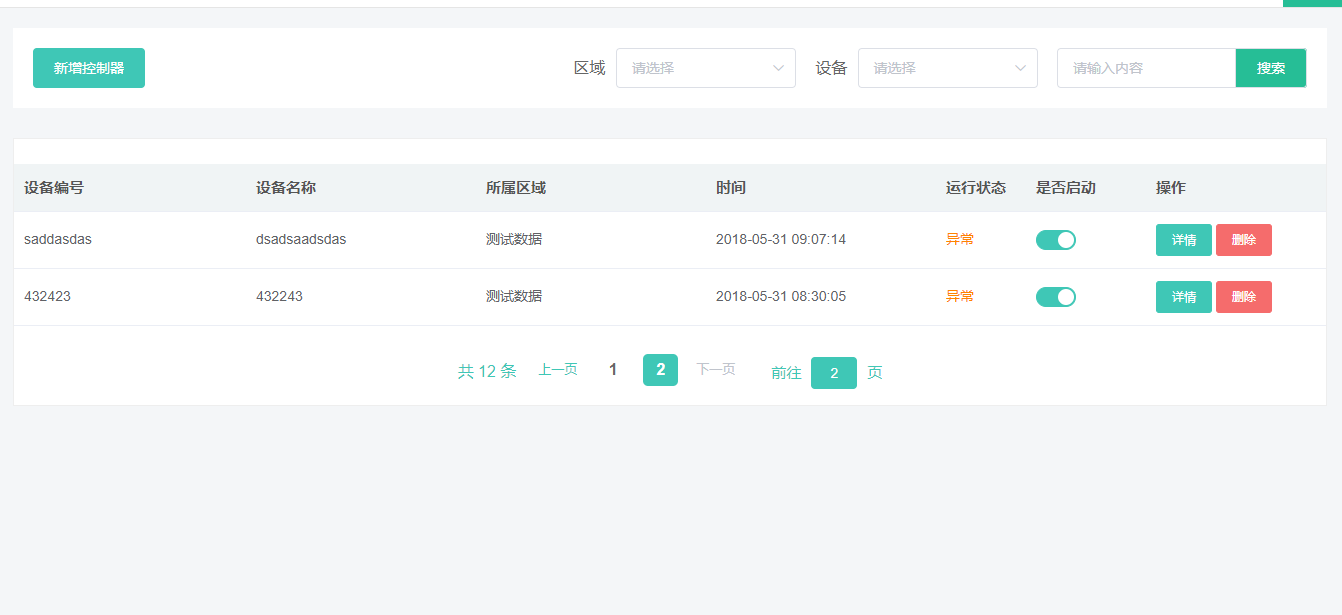
1. watch 与 computed 的巧妙结合
如上图,一个简单的列表页面。
你可能会这么做:
created(){
this.fetchData()
},
watch: {
keyword(){
this.fetchData()
}
}
如果参数比较多,比如上图
- 关键字筛选,
- 区域筛选,
- 设备ID筛选,
- 分页数,
- 每页几条数据,
可能会是这样:
data(){
return {
keyword:'',
region:'',
deviceId:'',
page:1
}
},
methods:{
fetchData(paramrs={
keyword:this.keyword,
region:this.region,
deviceId:this.deviceId,
page:this.page,
}){
this.$http.get("/list",paramrs).then("do some thing")
}
},
created(){
this.fetchData()
},
watch: {
keyword(data){
this.keyword=data
this.fetchData()
},
region(data){
this.region=data
this.fetchData()
},
deviceId(data){
this.deviceId=data
this.fetchData()
},
page(data){
this.page=data
this.fetchData()
},
requestParams(params){
this.fetchData(params)
}
}
不过这么写,明显有问题,主要是watch了很多参数,而且函数的处理都差不多,可以修改一下,通过methods处理
data(){
return {
keyword:'',
region:'',
deviceId:'',
page:1
}
},
methods:{
paramsChange(paramsName,paramsValue){
this[paramsName]=paramsValue
this.fetchData()
},
fetchData(paramrs={
keyword:this.keyword,
region:this.region,
deviceId:this.deviceId,
page:this.page,
}){
this.$http.get("/list",paramrs).then("do some thing")
}
},
created(){
this.fetchData()
}
当然这么写,需要在模板里面每个参数change的地方绑定事件,并传递参数值,比如分页change时:
<el-pagination
layout="total, prev, pager, next, jumper"
:total="total"
prev-text="上一页"
next-text="下一页"
@current-change="paramsChange('page',$event)"
>
</el-pagination>
相比上面的各种watch,代码明显少了很多,但是还有一个问题,那就是要在template的很多地方绑定change事件。
最后,当然是使用我们重点推荐的computed + watch了
data(){
return {
keyword:'',
region:'',
deviceId:'',
page:1
}
},
computed:{
requestParams() {
return {
page: this.page,
region: this.region,
id: this.deviceId,
keyword: this.keyword
}
}
},
methods:{
fetchData(paramrs={
keyword:this.keyword,
region:this.region,
deviceId:this.deviceId,
page:this.page,
}){
this.$http.get("/list",paramrs).then("do some thing")
}
},
watch: {
requestParams: {
handler: 'fetchData',
immediate: true
}
},
通过增加一个computed属性,watch这个属性并设置immediate为true,无需再手动绑定事件,相比之上的方法都要简洁。当然,缺点就是对性能稍微有些影响,不过问题不大。
2. 使用mixin提取公共部分
很多列表页其实使用的很多属性都是一样的,比如
- 分页 page
- 数量 size
- 搜索关键 字keyword
- 表格数据 tableData
这些公共的部分其实可以通过mixin来提取出来
/**
* mixin/table.js
*/
export default {
data() {
return {
keyword: '',
requestKeyword: '',
pages: 1,
size: 10,
total: 0,
tableData: []
}
}
}
在要用到的页面
import mixin from '@/mixin/table'
export default {
mixins: [mixin],
data() {
return {
selectRegion: '',
selectDevice: '',
deviceList: [],
}
}
/* 其他代码 */
...
3. 自动注册全局组件
正常情况下,我们需要使用一个我们自己封装的组件时,需要先引入,再注册,最后才能在template模板中使用。
<template>
<all-region :selectRegion="selectRegion" @region-change="selectRegion=$event"/>
</template>
<script>
import AllRegion from './baseButton'
export default {
components: {
AllRegion,
}
}
</script>
当有多个页面需要用到这些组件时,那么就需要在每个需要的页面重复这些步骤。
为了简化这些步骤,可以考虑把这些组件作为全局组件来使用,这样每个页面需要时,就可以直接使用了。
不过还有一个问题,那就是需要我们手动的全局注册。
/* main.js */
import Component1 from '@/component/compenent1'
import Component2 from '@/component/compenent2'
import Component3 from '@/component/compenent3'
Vue.component('component1', Component1)
Vue.component('component2', Component2)
Vue.component('component3', Component3)
当组件多了以后,手动注册也变得繁琐起来,可以通过require.context()实现自动注册组件。
/**
* main.js
* 读取componetns下的vue文件并自动注册全局组件
*/
const requireComponent = require.context('./components', false, /.vue$/)
requireComponent.keys().forEach(fileName => {
const componentConfig = requireComponent(fileName)
const componentName = fileName.replace(/^.//, '').replace(/.vue/, '')
Vue.component(componentName, componentConfig.default || componentConfig)
})
4. 自动注册vuex模块
之前我们是这么注册vuex模块的 ```javascript /* module.js */import alarm from './modules/alarm'
import history from './modules/history'
import factory from './modules/factory'
import contact from './modules/contact'
import company from './modules/company';
import deviceManage from './modules/device-manage'
import deviceModel from './modules/device-model'
import deviceActivation from './modules/device-activation'
import user from './modules/user'
import role from './modules/role'
import setAlarm from './modules/setAlarm'
import factoryMode from "./modules/factoryMode";
import ScreenDeviceWatch from './modules/screen-device-watch'
import ScreenDeviceForecast from './modules/screen-device-forecast'
export default {
alarm,
company,
deviceManage,
deviceModel,
user,
factory,
contact,
deviceActivation,
history,
role,
setAlarm,
factoryMode,
ScreenDeviceWatch,
ScreenDeviceForecast,
}
/* index.js */
import Vue from 'vue'
import Vuex from 'vuex'
import state from './state'
import getters from './getters'
import modules from './modules'
import actions from './actions'
import mutations from './mutations'
Vue.use(Vuex)
export default new Vuex.Store({
state,
getters,
mutations,
actions,
modules
})
可以发现每个模块都要我们手动导入,然后加入到module里面,如此重复。当模块不多还好,假如项目大了,有50个模块,那就得要做很多重复的工作。
跟注册组件一样,我们还是利用`require.context`来实现。
```javascript
/**
* 读取./modules下的所有js文件并注册模块
*/
const requireModule = require.context('./modules', false, /.js$/)
const modules = {}
requireModule.keys().forEach(fileName => {
const moduleName = fileName.replace(/(./|.js)/g, '')
modules[moduleName] = {
namespaced: true,
...requireModule(fileName).default
}
})
export default modules
/* index.js */
import Vue from 'vue'
import Vuex from 'vuex'
import modules from './modules'
Vue.use(Vuex)
export default new Vuex.Store({
state,
getters,
mutations,
actions,
modules
})